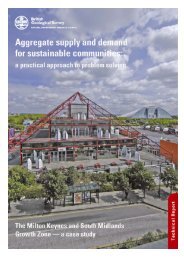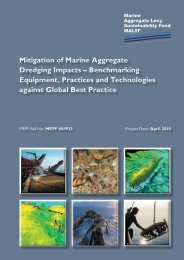creating environmental improvements through biodiversity
creating environmental improvements through biodiversity
creating environmental improvements through biodiversity
Create successful ePaper yourself
Turn your PDF publications into a flip-book with our unique Google optimized e-Paper software.
6 CONCLUSIONS<br />
A number of common themes were noted <strong>through</strong>out the reviewed reports,<br />
while several gaps in knowledge and issues for further research were<br />
identified. Some important issues are highlighted here and recommendations<br />
are made for co-ordination and communication of knowledge, including the<br />
future dissemination of ALSF-funded research.<br />
6.1 MAIN CONCLUSIONS:<br />
The value of stakeholder engagement is a common feature of many of the projects – in many cases ALSF<br />
work has brought all types of stakeholders together for the first time.<br />
Sustainable Aggregates Creating Environmental Improvements <strong>through</strong> Biodiversity<br />
Early discussion between stakeholders on issues affecting <strong>biodiversity</strong> benefits all involved, and can lead to<br />
innovative ways of resolving issues (including where minerals site restoration and determination of end-uses<br />
are involved.)<br />
Habitat creation on minerals sites should achieve high quality target habitats covering significant areas<br />
– restoration to ‘nature conservation’ as a smaller part of amenity end-use rarely provides worthwhile gains<br />
for <strong>biodiversity</strong>.<br />
A fund to enable Mineral Planning Authorities to investigate which areas within their authorities should be<br />
priorities for <strong>creating</strong> which habitats on mineral sites, depending on their location, would be very useful.<br />
A tool for identifying the habitats appropriate on potential future minerals sites would be extremely<br />
advantageous<br />
Landscape scale approaches to site restoration are highly beneficial for <strong>biodiversity</strong>.<br />
Co-ordinated monitoring of <strong>biodiversity</strong> on minerals sites, from pre-extraction to restoration, should be<br />
carried out in order to inform decisions.<br />
Centralised recording of monitoring data would be extremely useful, and allow improved dissemination of<br />
information and sharing of best practice.<br />
A number of useful handbooks and sources of information and guidance are named in the reviewed reports.<br />
These are highlighted within the body of this review.<br />
Perceived blocks to habitat creation as a minerals site end-use can often be overcome by early consideration<br />
in the planning process. Dissemination of innovative solutions and good practice will be also beneficial, and<br />
more research is needed on particular blocks - especially bird strike.<br />
35

















